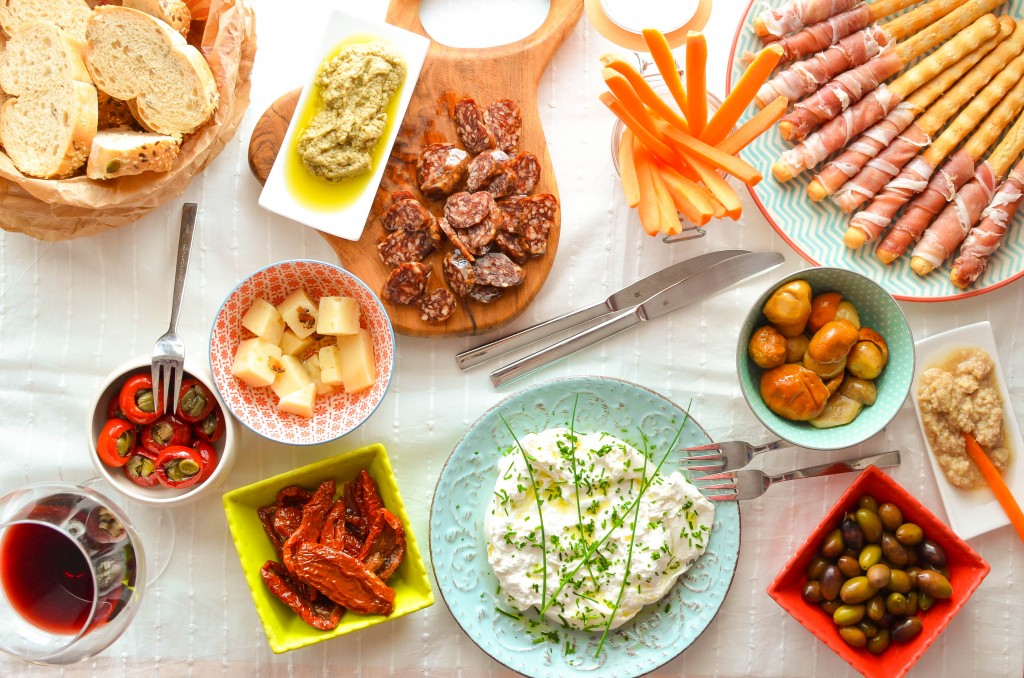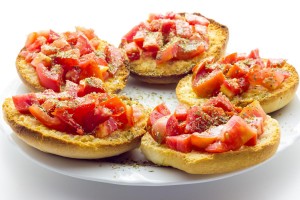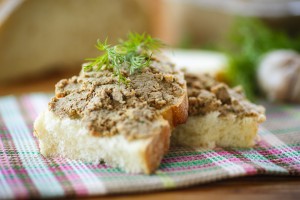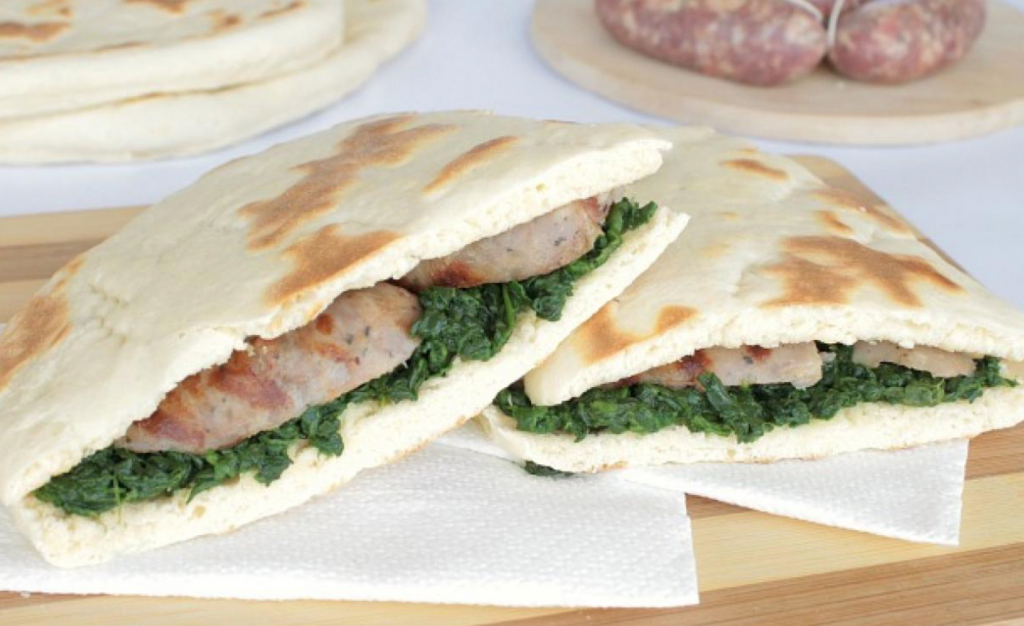Every national cuisine has its own way to stimulate the appetite for the main dishes. Traditionally in our cuisine, cold appetizers, salads or relishes are offered before the main dishes, together with beer or brandy. In Italy however, before lunch and especially before dinner are offered starters called ‘antipasti’ to which the Italians add a glass of local wine or ‘spritz’.
There is hardly anyone who doesn’t know what the appetizers are, but still, if there is someone, we will say that “appetizers” are the food that stimulates the appetite and prepares us for the main dish that follows.
We mentioned that every national cuisine offers similar food to stimulate appetite, but as our topic is the “Italian cuisine appetizers” we are going to talk a little more extensively about the Italian cuisine and the famous antipasti without which the culinary tradition of Italy would not be what it is.
History and Origin of the appetizers (antipasti)
The tradition of offering antipasti before the main dish originates from ancient Rome, as evidenced by texts that are found, mentioning “gustatio” (vegetable appetizers and sauces offered as a ‘prelude’ to the main meat meals).
Even Cicero had written about these appetizers calling them the “promulsisa” referring to the custom of drinking wine and honey which the Romans called the “mulsis”, during the great banquets in ancient Rome.
In the Middle Ages, the tradition of serving and consuming the antipasti sank into oblivion, and during the great holidays and gatherings, people started directly with the main dish.
The antipasti tradition was revived in the 16th century, and during this period, Pellegrino Arthussi (the father of the Italian gastronomy) wrote in his writings perhaps the first definition of appetizer:
“Appetizers are those small things that unlock the appetite for eating. Prepared from oysters, cold meats, ham, salami, tongue, mortadella, cheese, anchovies, sardines. “
Today in the Italian cuisine, appetizers are offered not only during great banquets, but they are an integral part of the Italian national cuisine.
The development that they went through over the centuries was enormous. The change had been made both because of upgrading in the customers’ tastes and also, because of the vast variety of antipasti recipes that have been offered. The choice is really great: from recipes based on fish, meat, cheese, vegetables to the various cooking techniques (fried, baked, raw, cooked) and various tastes (salty, sweet, pungent, intense).
In addition, the fact that in each region in Italy the different appetizers are prepared in a different way and with the specific regional ingredients, it becomes rather difficult to say which are the most frequently-prepared and the most popular Italian starters.
Northern Italy
Stretching to the Alps, Northern Italy is famous for its creamier appetizers, which are prepared from the delicious dairy products that are produced on the hills and pastures of this part of the country.
Another distinguishing feature of the Northern Italian appetizers is the use of fresh herbs, bacon, dry-cured meat and vegetables.
Central Italy
While the northern region is famous for its dairy products, Central Italy is an area known for its variety of smoked meat, seafood, cheese and, of course, rich, aromatic sauces.
Central Italy is blessed with a variety of food from the sea and the earth, so it is not surprising that in this part of the country the most popular starters in the Italian cuisine are of seafood, meat and cheese, prosciutto, salami, smoked salmon and fresh spices.
South Italy
In this region, the traditional Italian and Mediterranean cuisines are in ‘symbiosis’, so the appetizers typical of Southern Italy most often include fresh tomatoes and herbs combined with creamy kind of cheese and a variety of fresh seafood.
Popular Starters by Region
Central Italy
Bruschetta with tomatoes
This perhaps is the most renowned and popular appetizer in the Italian cuisine.
Products:
For 4 starters 4 slices of bread, tomatoes, marjoram, garlic, basil, olive oil and a little salt are needed.
Preparation:
In a bowl put the tomatoes cut into small cubes and the garlic cut into slices. Add all other herbs and spices to them. Mix everything well.
The bread slices are toasted to obtain golden colour.
Put of the mixture on each slice (brochette) and the antipasti are ready for consumption.
Crostini Toscani di fegatini (Tuscan crostini with chicken liver)
Products for 4 people:
350 g chicken liver
50 g of caper
½ broth
½ glass of Vinsanto
1 onion (middle size)
2 – 3 pieces of anchovy
Olive oil
Preparation:
Chicken liver is washed and dried well. The onion and the capers are fried until they are ready. Once the onion becomes a golden colour, the liver and the wine are added. The antipasto is allowed to boil for another 20 minutes.
Once it has been removed from the cooker and has cooled down, the liver can be chopped in small pieces or everything together can be blended well. The anchovy and the capers can be added at the end, or they can be blended together with the liver.
Several slices of Tuscan bread are toasted and the blended mixture is spread on them.
Torta al Testo
Torta al Testo or Crescia is a traditional unleavened bread from the region of Umbria, Central Italy. The origin of this delicious appetizer dates back from the Roman Empire when these thin, round loaves were baked on large brick discs called ‘testum’. Nowadays, ‘testo’ refers to a cast-iron pan on which the “cake” is prepared.
Products:
500 grams of flour
1 pinch of sea salt
½ teaspoon of baking soda
250 ml of lukewarm water
20 ml of olive oil
Preparation:
All products are mixed and kneaded in a medium soft dough. Once shaped, the dough is covered with a cloth and left still for a few minutes.
Then the dough is divided into balls which are shaped into round flatbread (the shape is similar to our ‘parlenki’).
Each flatbread is baked on both sides well (for about 7 – 8 minutes).
After cooling slightly, they are garnished, at your desire, with sausage, ham, different types of cheese or salami.
Northern Italy
Bovoli Conzi – an appetizer of earth snails
This appetizer is typical of Veneto, Northern Italy.
Products:
500 g cleaned Earth’s snails
1 lemon
1 garlic clove
Several sprigs of parsley
Olive oil
salt
Preparation:
The washed-and-cleaned snails are put in a saucepan to boil until they are ready. While they are boiled, the finely chopped parsley and garlic are mixed together and the lemon juice, olive oil, and salt are added.
The boiled snails are removed and drained well, placed on a plate and served with the mixture of spices poured over.
Sardines with raisins and cedar nuts
Products for 4 servings:
100 g of flour
600 g of sardines
Butter for frying
50 g of raisins
50 g of cedar nuts
Spoons of dry white wine
1 onion
A little vinegar
salt
Preparation:
The raisins are placed in a glass of water for about 10 minutes. During that time the sardines are cleaned thoroughly – their entrails and heads are removed, then, the sardines are fried in butter.
The onion is cut and fried. Shortly before it is ready, 3 tablespoons of wine and salt are added to it. After a few minutes, the cedar nuts, the raisins are added, as well as the vinegar and the rest of the wine. Everything should be cooked until it remains only in fat.
It is arranged on a plate in a row of sardines, a row of onion sauce, a row of sardines, a row of onion sauce, etc., until the products finish.
The antipasto is allowed to cool well. It is served with a green salad at your choice.
An appetizer of Figs, Ham and Parmesan
This is one of the most popular appetizers that you can try in Northern Italy, especially in Bologna.
Figs, prosciutto, and parmesan are the perfect summer appetizer, which is prepared quickly and without any effort.
The secret of this antipasto is in the … figs. They must be very well ripe, and must be prepared just before the antipasto is consumed.
Products for 4 people:
400 grams of whole, well ripe figs
240 grams of prosciutto
120 grams of Parmesan cheese
Preparation:
The figs are washed thoroughly and dried. The skin is removed and they are cut into halves (if harder, they can be cut into smaller pieces).
On a dish, or plateau, the slices of prosciutto are placed; the figs are arranged on the top; and finally, it is topped up with the grated cheese.
It is good for the starter to cool for 10-20 minutes before serving.
Southern Italy
Octopus ‘Luciana’
This starter is typical for the Neapolitan cuisine and its name comes from the fishermen of Santa Lucia.
Necessary products for 4 people:
1 kilogram of small octopus
500 g of fresh tomatoes
50 ml of olive oil
2 garlic cloves
1 chili pepper
1 bunch of parsley
Black olives, capers, black pepper, salt
Preparation:
The octopus is washed and cleaned well, then put in a bowl with olive oil together with the finely chopped garlic and a little bit of black pepper. All that is cooked for a few minutes at a high temperature, then the temperature is reduced. The lid of the dish is placed on the top and the octopus is cooked for another 30 minutes at low temperature. A little before the dish is removed from the hob, the tomato sauce is added, which is pre-cooked with garlic. The olives and capers are added and everything is cooked together for at least half an hour. The Neapolitan antipasto is served sprinkled with parsley (pre-cut and lightly fried); it is consumed with a glass of white sparkling wine.
Aubergine rolls, zucchini, bacon, and mozzarella
Products for 4 people:
2 long aubergines
2 zucchinis
Mozzarella
2 eggs
60 g of bacon
Parmesan cheese
Olive oil, salt, black pepper, bread-crumbs
Preparation:
The aubergines and the zucchinis are washed and cut into long strips. The aubergine strips are rolled into whipped eggs and parmesan and fried in olive oil. After that, they are left on paper to absorb the fat from the frying.
The zucchini strips are grilled lightly.
Each roll is prepared by placing the bacon strip at the bottom, then the fried aubergine strip; the grilled zucchini strip, and finally the mozzarella. The products are rolled up and each roll is placed on a baking tray. The rolls should be baked at 200 degrees for a few minutes. The appetizer is served warm.

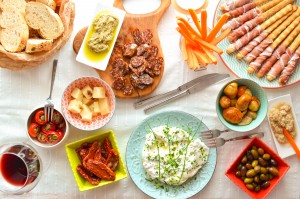
![[:bg]Италианска кухня предястия[:en]Appetizers in the Italian cuisine[:] | Leonardo Bansko](https://leonardobansko.com/wp-content/uploads/2018/07/Италианска-кухня-предястия-945x385.jpg)
